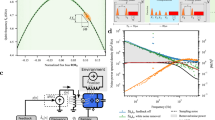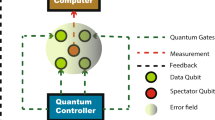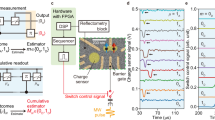Abstract
Engineering desired operations on qubits subjected to the deleterious effects of their environment is a critical task in quantum information processing, quantum simulation and sensing. The most common approach relies on open-loop quantum control techniques, including optimal-control algorithms based on analytical1 or numerical2 solutions, Lyapunov design3 and Hamiltonian engineering4. An alternative strategy, inspired by the success of classical control, is feedback control5. Because of the complications introduced by quantum measurement6, closed-loop control is less pervasive in the quantum setting and, with exceptions7,8, its experimental implementations have been mainly limited to quantum optics experiments. Here we implement a feedback-control algorithm using a solid-state spin qubit system associated with the nitrogen vacancy centre in diamond, using coherent feedback9 to overcome the limitations of measurement-based feedback, and show that it can protect the qubit against intrinsic dephasing noise for milliseconds. In coherent feedback, the quantum system is connected to an auxiliary quantum controller (ancilla) that acquires information about the output state of the system (by an entangling operation) and performs an appropriate feedback action (by a conditional gate). In contrast to open-loop dynamical decoupling techniques10, feedback control can protect the qubit even against Markovian noise and for an arbitrary period of time (limited only by the coherence time of the ancilla), while allowing gate operations. It is thus more closely related to quantum error-correction schemes11,12,13,14, although these require larger and increasing qubit overheads. Increasing the number of fresh ancillas enables protection beyond their coherence time. We further evaluate the robustness of the feedback protocol, which could be applied to quantum computation and sensing, by exploring a trade-off between information gain and decoherence protection, as measurement of the ancilla–qubit correlation after the feedback algorithm voids the protection, even if the rest of the dynamics is unchanged.
This is a preview of subscription content, access via your institution
Access options
Subscribe to this journal
Receive 51 print issues and online access
$199.00 per year
only $3.90 per issue
Buy this article
- Purchase on Springer Link
- Instant access to full article PDF
Prices may be subject to local taxes which are calculated during checkout



Similar content being viewed by others
References
Boscain, U. & Mason, P. Time minimal trajectories for a spin 1/2 particle in a magnetic field. J. Math. Phys. 47, 062101 (2006)
Khaneja, N., Reiss, T., Kehlet, C., Schulte-Herbrüggen, T. & Glaser, S. J. Optimal control of coupled spin dynamics: design of NMR pulse sequences by gradient ascent algorithms. J. Magn. Reson. 172, 296–305 (2005)
Wang, X. & Schirmer, S. G. Analysis of Lyapunov method for control of quantum states. Automatic Control. IEEE Trans. Automatic Control 55, 2259–2270 (2010)
Ajoy, A. & Cappellaro, P. Quantum simulation via filtered Hamiltonian engineering: application to perfect quantum transport in spin networks. Phys. Rev. Lett. 110, 220503 (2013)
Wiseman, H. M. & Milburn, G. J. Quantum theory of optical feedback via homodyne detection. Phys. Rev. Lett. 70, 548–551 (1993)
Doherty, A. C., Jacobs, K. & Jungman, G. Information, disturbance, and Hamiltonian quantum feedback control. Phys. Rev. A 63, 062306 (2001)
Vijay, R. et al. Stabilizing Rabi oscillations in a superconducting qubit using quantum feedback. Nature 490, 77–80 (2012)
Sayrin, C. et al. Real-time quantum feedback prepares and stabilizes photon number states. Nature 477, 73–77 (2011)
Lloyd, S. Coherent quantum feedback. Phys. Rev. A 62, 022108 (2000)
Viola, L., Knill, E. & Lloyd, S. Dynamical decoupling of open quantum systems. Phys. Rev. Lett. 82, 2417–2421 (1999)
Shor, P. W. Fault-tolerant quantum computation. In 37th Annual Symposium on Foundations of Computer Science 56–65 (IEEE Comput. Soc., 1996)
Taminiau, H. T., Cramer, J., van der Sar, T., Dobrovitski, V. V. & Hanson, R. Universal control and error correction in multi-qubit spin registers in diamond. Nature Nanotechnol . 9, 171–176 (2014)
Waldherr, G. et al. Quantum error correction in a solid-state hybrid spin register. Nature 506, 204–207 (2014)
Cramer, J. et al. Repeated quantum error correction on a continuously encoded qubit by real-time feedback. Preprint at http://arXiv.org/abs/1508.01388 (2015)
Ticozzi, F. & Viola, L. Single-bit feedback and quantum-dynamical decoupling. Phys. Rev. A 74, 052328 (2006)
Griffiths, R. & Niu, C.-S. Semiclassical Fourier transform for quantum computation. Phys. Rev. Lett. 76, 3228–3231 (1996)
Kessler, E. M., Lovchinsky, I., Sushkov, A. O. & Lukin, M. D. Quantum error correction for metrology. Phys. Rev. Lett. 112, 150802 (2014)
Arrad, G., Vinkler, Y., Aharonov, D. & Retzker, A. Increasing sensing resolution with error correction. Phys. Rev. Lett. 112, 150801 (2014)
Unden, T. et al. Quantum metrology enhanced by repetitive quantum error correction. Preprint at http://arXiv.org/abs/1602.07144 (2015)
Chen, M., Hirose, M. & Cappellaro, P. Measurement of transverse hyperfine interaction by forbidden transitions. Phys. Rev. B 92, 020101 (2015)
Jacques, V. et al. Dynamic polarization of single nuclear spins by optical pumping of nitrogen-vacancy color centers in diamond at room temperature. Phys. Rev. Lett. 102, 057403 (2009)
Laraoui, A. et al. High-resolution correlation spectroscopy of 13C spins near a nitrogen-vacancy centre in diamond. Nature Commun . 4, 1651 (2013)
Ryan, C. A., Hodges, J. S. & Cory, D. G. Robust decoupling techniques to extend quantum coherence in diamond. Phys. Rev. Lett. 105, 200402 (2010)
Morton, J. J. L. et al. Solid-state quantum memory using the 31P nuclear spin. Nature 455, 1085–1088 (2008)
Kim, Y.-H., Yu, R., Kulik, S. P., Shih, Y. & Scully, M. O. Delayed “choice” quantum eraser. Phys. Rev. Lett. 84, 1–5 (2000)
Steiner, M., Neumann, P., Beck, J., Jelezko, F. & Wrachtrup, J. Universal enhancement of the optical readout fidelity of single electron spins at nitrogen-vacancy centers in diamond. Phys. Rev. B 81, 035205 (2010)
Pla, J. J. et al. High-fidelity readout and control of a nuclear spin qubit in silicon. Nature 496, 334–338 (2013)
Wolfowicz, G. et al. Conditional control of donor nuclear spins in silicon using stark shifts. Phys. Rev. Lett. 113, 157601 (2014)
Widmann, M. et al. Coherent control of single spins in silicon carbide at room temperature. Nature Mater . 14, 164–168 (2015)
Chekhovich, E. A. et al. Nuclear spin effects in semiconductor quantum dots. Nature Mater . 12, 494–504 (2013)
Lindblad, G. On the generators of quantum dynamical semigroups. Commun. Math. Phys. 48, 119–130 (1976)
Bloch, F. Generalized theory of relaxation. Phys. Rev. 105, 1206–1222 (1957)
Kälin, M. & Schweiger, A. Radio-frequency-driven electron spin echo envelope modulation spectroscopy on spin systems with isotropic hyperfine interactions. J. Chem. Phys . 115, 10863–10875 (2001)
Mims, W. B. Envelope modulation in spin-echo experiments. Phys. Rev. B 5, 2409–2419 (1972)
Neumann, P. et al. Excited-state spectroscopy of single NV defects in diamond using optically detected magnetic resonance. New J. Phys. 11, 013017 (2009)
Meriles, C. A. et al. Imaging mesoscopic nuclear spin noise with a diamond magnetometer. J. Chem. Phys . 133, 124105 (2010)
Nielsen, M. A. & Chuang, I. L. Quantum Computation and Quantum Information Ch. 4 (Cambridge Univ. Press, 2003)
Acknowledgements
We thank L. Viola, F. Ticozzi, M. Lukin and F. Jelezko for discussions. This work was supported in part by the US Air Force Office of Scientific Research grant number FA9550-12-1-0292 and by the US Office of Naval Research grant number N00014-14-1-0804.
Author information
Authors and Affiliations
Contributions
M.H. and P.C. contributed to all aspects of this work.
Corresponding author
Ethics declarations
Competing interests
The authors declare no competing financial interests.
Extended data figures and tables
Extended Data Figure 1 Feedback circuit.
See, for example, ref. 37 for an explanation of the notation. a, b, Measurement-based (a) and coherent (b) feedback algorithms. In the shaded regions we highlight the differences between the two strategies. The measurement-based protocol requires a measurement of the ancilla and subsequent classically controlled operation (double lines indicate a classical wire). The coherent feedback protocol does not perform a measurement, but requires a coherent controlled operation. c, Re-initializing the ancilla or using multiple fresh ancillas can extend the feedback protection beyond the coherence time of the ancilla. d, A concatenated feedback algorithm with two ancillas can protect the qubit from general noise (applied along any axis).
Extended Data Figure 2 Protected gate
. The feedback algorithm is compatible with the application of NOT gates at any point during the protection time. a, Rabi oscillations embedded in the feedback-based protection algorithm. b, When the NOT gate is applied in the middle of the protection time, it halves the period of the oscillations due to the hyperfine coupling; see equation (1). c, More complex evolution is obtained when inserting the NOT gate at other times. Here we show the behaviour for τπ = τ/4. Black circles are experimental data with error bars representing their standard deviation (see Fig. 2); the solid lines are fits using equation (1). PL, photoluminescence.
Extended Data Figure 3 Weak measurement circuit.
a, After the feedback algorithm is completed, a controlled-X rotation entangles the qubit with the ancilla, allowing us to perform a partial measurement of the ancilla:  . The strength of the measurement can be adjusted by the angle ϕ. b, The control sequence in a is simplified by combining the partial measurement gates with the preceding gates of the feedback algorithm. As a result, to implement the weak correlated measurement in the experiment, we simply perform a controlled-phase rotation gate with θ = π/2 − ϕ, instead of the controlled-Z (θ = π) rotation that is required for the feedback algorithm.
. The strength of the measurement can be adjusted by the angle ϕ. b, The control sequence in a is simplified by combining the partial measurement gates with the preceding gates of the feedback algorithm. As a result, to implement the weak correlated measurement in the experiment, we simply perform a controlled-phase rotation gate with θ = π/2 − ϕ, instead of the controlled-Z (θ = π) rotation that is required for the feedback algorithm.
Extended Data Figure 4 Control and coherence of the nitrogen nuclear spin.
a, Typical control sequence. The first laser pulse initializes the spins into the |0, 1〉 state. After a nuclear-spin gate (radio-frequency (RF) driving), to detect the nuclear spin state we use a microwave (MW)-selective π pulse that maps the nuclear spin state onto that of the NV spin, which is subsequently detected by the second laser pulse. b, Nuclear magnetic resonance at about 390 G. We sweep the radio frequency at fixed pulse length. The dip in the photoluminescence (PL) spectrum indicates the resonant frequency of the |0, 1〉 ↔ |0, 0〉 transition. c, Nuclear Rabi oscillations. We drive resonantly the |0, 1〉 ↔ |0, 0〉 transition. The measured nutation rate (Rabi frequency) is Ωn ≈ 26.3 kHz (ref. 20). d, Nuclear Ramsey fringes under the sequence π/2–τ–π/2, where τ is the free evolution time. We measure a dephasing time of the nuclear spin  , which is limited by the NV electronic spin lattice relaxation process (T1 = 4.5 ms; red circles and dashed line). Error bars represent the standard deviation of the signal, calculated by error propagation from the photoluminescence intensity of the signal and reference photoluminescence curves acquired for each data point for mS = {0, −1}. Lines are fits to the data.
, which is limited by the NV electronic spin lattice relaxation process (T1 = 4.5 ms; red circles and dashed line). Error bars represent the standard deviation of the signal, calculated by error propagation from the photoluminescence intensity of the signal and reference photoluminescence curves acquired for each data point for mS = {0, −1}. Lines are fits to the data.
Extended Data Figure 5 Electronic- and nuclear-spin-dependent fluorescence at different magnetic field strengths.
At the lower magnetic field (left; B = 390 G), the fluorescence intensity shows only a weak dependence on the nuclear spin state in the mS = −1 manifold (indicated by the overlapping data), whereas at B = 514 G, which is very close to the ESLAC, a strong dependence on the nuclear spin state is observed in both manifolds (right; indicated by the non-overlapping data). From these fluorescence measurements, we obtained the parameters (ε, η) used to model the measurement operator. In the experiments, the detection time delay and window were optimized to obtain the maximum contrast of the state at each magnetic field.
Rights and permissions
About this article
Cite this article
Hirose, M., Cappellaro, P. Coherent feedback control of a single qubit in diamond. Nature 532, 77–80 (2016). https://doi.org/10.1038/nature17404
Received:
Accepted:
Published:
Issue Date:
DOI: https://doi.org/10.1038/nature17404
This article is cited by
-
Real-time two-axis control of a spin qubit
Nature Communications (2024)
-
Probing two-qubit capacitive interactions beyond bilinear regime using dual Hamiltonian parameter estimations
npj Quantum Information (2023)
-
Noisy intermediate-scale quantum computers
Frontiers of Physics (2023)
-
Quantum Optimal Control for Pauli Operators Based on Spin-1/2 System
International Journal of Theoretical Physics (2022)
-
Nuclear spin assisted magnetic field angle sensing
npj Quantum Information (2021)
Comments
By submitting a comment you agree to abide by our Terms and Community Guidelines. If you find something abusive or that does not comply with our terms or guidelines please flag it as inappropriate.



